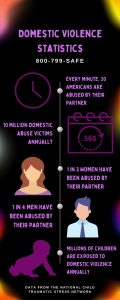The month of October is Domestic Violence Awareness Month. First observed in October of 1987, the month was officially selected as Domestic Violence Awareness Month in 1989 when Congress passed Public Law 101-112. This Public Law requests that those residing in the United States of America should observe this month and become educated on the topic of domestic violence.
Throughout October, those affected by domestic violence and advocates in the community unite together to pay their respects to the lives taken by domestic violence. The month is also spent working towards a future that is rid of domestic violence, while also celebrating previous accomplishments made towards the effort.
On Oct. 19, Go Purple Day, is the national day of action that occurs during Domestic Violence Awareness Month. Advocates throughout the nation are encouraged to wear purple in solidarity with those affected by the epidemic. Wearing purple also symbolizes an individual’s personal effort towards a future free of domestic violence.
It does not matter what someone’s personal background looks like, domestic violence can affect anyone. The atrocity does not discriminate against age, gender identity, sexual orientation, race or religion. While the abuse inflicted on an individual can sometimes be fatal, victims of domestic violence experience physical and emotional trauma. It is averaged that every minute nationwide, 20 people are abused by their partner. This statistic reveals that each year, there are over 10 million victims of domestic abuse. The epidemic of domestic violence keeps millions of Americans, every year, in an unsafe environment.
DOMESTIC VIOLENCE IS NOT A GENDERED CRIME
The idea that domestic violence is an issue that only affects women, is a harmful misconception. Due to the age-old societal norm that men should not express emotion, men are less likely to come forward with their experiences as a victim of domestic violence. As a result of this, men across America hesitate to get themselves help, causing them to undergo severe psychological damage.
Organizations that advocate for domestic violence, like Family Crisis Centers, have found that men often feel discouraged to come forward with their experience as a survivor of domestic violence. A reason behind this includes that men are sometimes told they are overreacting when they speak out against the abuse they experienced. This invalidates a victim’s feelings, furthering the psychological effects that they struggle with.
But this fact does not diminish the domestic violence that is committed against women. Domestic violence is an infringement on one’s human rights. According to the World Health Organization (WHO), 27% of women between the ages of 15 to 49 – with a relationship history – report that they have been abused by their partner. Physical, sexual and psychological violence against women can result in physical, mental and reproductive health problems. These problems include (but are not limited to): increased likelihood of miscarriage, unintended pregnancy, stillbirth, depression, PTSD, issues with sleeping, eating disorders and attempted suicide.
Ms. Michaela Kruger teaches the Women’s Health Issues class at Owatonna High School. The class focuses on creating a healthy environment for women to thrive in, while also addressing issues that affect women in society, including domestic violence and abuse against women. Ms. Kruger said, “It is important that people are aware that it’s going on and are aware that it occurs even though it can be an uncomfortable conversation sometimes.” All survivors deserve to receive the help that they need, regardless of gender.
CHILDREN AFFECTED BY DOMESTIC VIOLENCE
Children who witness domestic violence are subject to emotional, mental and social damage, which affects their childhood development. Depending on age, children will react differently to being exposed to a violent home setting. The effects from this exposure can range from short-term to long-term.
Preschool aged children exposed to domestic abuse in their home may revert back to habits they had when they were younger. Examples include bed-wetting, thumb-sucking and outbursts of crying. Their sleep will also be affected and can be interrupted by nightmares and other signs of terror. Preschool aged children will also be subject to severe separation anxiety. This can cause panic attacks and will also disrupt education and daily activities.
Children in the school age range, 6 to 12, sometimes blame themselves for the abuse they witness within their homes. Which affects their self-esteem and their mental health affecting their participation in daily activities. This lack of participation and self-esteem makes it difficult for these children to have relationships with their peers, putting a strain on friendships and healthy connections. Behavioral issues are also more common in school aged children exposed to domestic violence, further affecting their participation in daily activities.
Teenagers, ages 13 to 17, will also be affected behaviorally. This includes engaging in harmful practices (drugs, alcohol, getting in trouble with the law, bullying others, etc.), fighting with family members and not attending school. Similarly to children aged 6 to 12, teenagers will also have their self-esteem and friendships affected by being exposed to domestic violence. Teenage boys are more likely to engage in bullying and illegal behavior, while teenage girls are more likely to withdraw from daily activities and struggle with depression.
Domestic violence does not only harm the victim, but it harms the witnesses and causes trauma that needs to be evaluated and treated.
— Anna Cox
Anna Cox, a senior at Owatonna High School, is a student in Ms. Kruger’s Women’s Health Issues class. Cox said, “Domestic violence does not only harm the victim, but it harms the witnesses and causes trauma that needs to be evaluated and treated.”
When help is received sooner rather than later, children who have been exposed to violence in their home will have a higher chance of recovering and growing into healthy adults. But it is important to remember that every individual child is different, and they will recover from trauma at different rates and in different ways. Healthy relationships with trusted adults, high self-esteem and supportive friendships are essential for a child in recovery. While children will most likely remember the violence that they witnessed, they can learn healthy coping mechanisms and effective ways to handle their emotions that will be beneficial to them as they mature.
According to the American Academy of Child and Adolescent Psychiatry, three to 10 million children and adolescents – each year – will witness domestic violence within their homes. Both the victim of abuse and the children exposed to abuse deserve treatment from medical health professionals. This can include individual, group or family therapy, and medication is prescribed in some situations. Victims of abuse should develop a crisis plan. A crisis plan provides a safe place for the victims to stay, and the availability of transportation, childcare and financial support.
BREAKING THE CYCLE OF DOMESTIC VIOLENCE

The issue of domestic violence can be prevented by society uniting together to spread awareness. Breaking the cycle of domestic violence requires addressing its root causes within the families and communities affected by it. Since it is a multi-generational cycle, prevention includes working across generations to promote healing and to provide a healthy trajectory for families and individuals to follow.
According to Mayo Clinic, domestic violence always involves an imbalance of power, and it is important to recognize the warning signs of an abusive relationship. Warning signs in a relationship include: being prevented from seeing family and friends, jealous or possessive behavior, being blamed by a partner for their abusive behavior and constant insults or offensive name-calling. These are only a few of the warning signs in an abusive relationship, find more here.
It is not only critical to recognize warning signs in one’s own relationship, but also in the relationships of peers. Ms. Kruger said, “Perpetrators and people that promote domestic violence thrive when their victims feel like they’re all alone and they capitalize on that.” Supporting and validating victims throughout their experiences makes it easier for them to get the help they need on the road to recovery.
Although an abusive partner may apologize or promise it will not happen again, the cycle of domestic violence will repeat itself. Beware that the longer an individual stays in an abusive relationship, the more damaging the physical and emotional affect will be. Victims will also find it difficult to reach out for help because they are often blamed by their partner for the abuse they are experiencing, leading them to blame themselves as well.
To break the cycle of domestic violence, action must be taken. This can mean a number of things. Telling a loved one, calling a National Domestic Violence Hotline and creating a safety plan are all steps of action towards leaving an abusive relationship. Victims recognizing that they are not at fault for their partners abusive behavior is the first step towards recovering from domestic violence.
HELP IS AVAILABLE
If an individual finds themselves in an emergency regarding domestic violence, 911 is available for call or text. Other available resources include: the National Domestic Violence Hotline (800-799-SAFE), the National Sexual Assault Hotline (800-656-HOPE), local health care providers and the Crisis Resource Center of Steele County.


